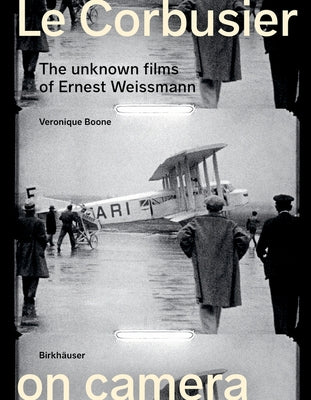Birkhauser
Le Corbusier on Camera: The Unknown Films of Ernest Weissmann
Le Corbusier on Camera: The Unknown Films of Ernest Weissmann
Regular price
$107.99
Regular price
Sale price
$107.99
Unit price
per
Couldn't load pickup availability
The book is
based on amateur films, shot by the architect Ernest Weissmann (1903-1985) with
a Pathé Motocamera in the years 1929-1933 at the Atelier Le Corbusier and
Pierre Jeanneret, among others. These films have never been published before
and capture moments from Le Corbusier's life that have never been seen before.
It also documents his friendships with Pierre Jeanneret, Josep Lluís Sert,
Charlotte Perriand, Norman Rice, Kunio Maekawa, Sigfried Giedion and others. In
six chapters, the book shows impressive stills of these films and places them
in the respective historical and personal context of Le Corbusier in
introductory texts. Two introductions are devoted to the history of these films and Ernest
Weissmann's life and his life-long relationship with Le Corbusier. -
A documentary treasure trove on the life of Le Corbusier - Featuring 80 previously unpublished film stills - Available as softcover (9783035627282), hardcover
(9783035627299) and limited special edition with three photographic prints
(9783035627305) Le Corbusier (1887-1965) is considered one of the most famous visionary
architects and urban designers of the 20th century. With his cousin, he ran the
Atelier Le Corbusier and Pierre Jeanneret from 1922 until 1940. During this
period, most of the practice's modernist villas were built, and bigger works
such as the Centrosoyus in Moscow, and the Cité de Refuge and the Pavillon
Suisse in Paris, realized. In parallel, Le Corbusier developed urban-design
projects for such cities as Paris, Antwerp, Algiers, and Buenos Aires, and
wrote extensively on his architectural and urbanistic ideas. He continued the
Atelier Le Corbusier on an individual base from 1940 on, with projects such as
the Unités d'Habitation in Marseilles and in Nantes-Rezé, Briey, Firminy, and
Berlin; the Monastery of Sainte-Marie de La Tourette; and the church of
Notre-Dame du Haut Ronchamp. He designed the new state capital of the north
Indian states of Punjab and Haryana, Chandigarh, with its representative
buildings, from 1951 on. Ernest Weissmann (1903-1985) was a Croatian (then-Yugoslav) architect
and developer/planner. He graduated in architecture in Zagreb, and worked for
Adolf Loos and Le Corbusier and Pierre Jeanneret in Paris. He dedicated his
work to the development of the prefabricated hospital-building type and city
planning viewed from social and economic points of view. He was an active
member of the Congrès Internationaux d'Architecture Moderne (CIAM) from 1929
until 1947. From 1942 until 1966, he worked for the United States Board of
Economic Warfare and United Nations Relief and Rehabilitation Administration, Economic
Commission, and Department of Economic and Social Affairs. At the UN, Weissmann
was in charge of housing, building, and planning at a global scale.
Author: Veronique Boone
Binding Type: Hardcover
Publisher: Birkhauser
Published: 03/15/2024
Pages: 176
Weight: 2.4lbs
Size: 10.79h x 8.50w x 0.87d
ISBN: 9783035627299
based on amateur films, shot by the architect Ernest Weissmann (1903-1985) with
a Pathé Motocamera in the years 1929-1933 at the Atelier Le Corbusier and
Pierre Jeanneret, among others. These films have never been published before
and capture moments from Le Corbusier's life that have never been seen before.
It also documents his friendships with Pierre Jeanneret, Josep Lluís Sert,
Charlotte Perriand, Norman Rice, Kunio Maekawa, Sigfried Giedion and others. In
six chapters, the book shows impressive stills of these films and places them
in the respective historical and personal context of Le Corbusier in
introductory texts. Two introductions are devoted to the history of these films and Ernest
Weissmann's life and his life-long relationship with Le Corbusier. -
A documentary treasure trove on the life of Le Corbusier - Featuring 80 previously unpublished film stills - Available as softcover (9783035627282), hardcover
(9783035627299) and limited special edition with three photographic prints
(9783035627305) Le Corbusier (1887-1965) is considered one of the most famous visionary
architects and urban designers of the 20th century. With his cousin, he ran the
Atelier Le Corbusier and Pierre Jeanneret from 1922 until 1940. During this
period, most of the practice's modernist villas were built, and bigger works
such as the Centrosoyus in Moscow, and the Cité de Refuge and the Pavillon
Suisse in Paris, realized. In parallel, Le Corbusier developed urban-design
projects for such cities as Paris, Antwerp, Algiers, and Buenos Aires, and
wrote extensively on his architectural and urbanistic ideas. He continued the
Atelier Le Corbusier on an individual base from 1940 on, with projects such as
the Unités d'Habitation in Marseilles and in Nantes-Rezé, Briey, Firminy, and
Berlin; the Monastery of Sainte-Marie de La Tourette; and the church of
Notre-Dame du Haut Ronchamp. He designed the new state capital of the north
Indian states of Punjab and Haryana, Chandigarh, with its representative
buildings, from 1951 on. Ernest Weissmann (1903-1985) was a Croatian (then-Yugoslav) architect
and developer/planner. He graduated in architecture in Zagreb, and worked for
Adolf Loos and Le Corbusier and Pierre Jeanneret in Paris. He dedicated his
work to the development of the prefabricated hospital-building type and city
planning viewed from social and economic points of view. He was an active
member of the Congrès Internationaux d'Architecture Moderne (CIAM) from 1929
until 1947. From 1942 until 1966, he worked for the United States Board of
Economic Warfare and United Nations Relief and Rehabilitation Administration, Economic
Commission, and Department of Economic and Social Affairs. At the UN, Weissmann
was in charge of housing, building, and planning at a global scale.
Author: Veronique Boone
Binding Type: Hardcover
Publisher: Birkhauser
Published: 03/15/2024
Pages: 176
Weight: 2.4lbs
Size: 10.79h x 8.50w x 0.87d
ISBN: 9783035627299


